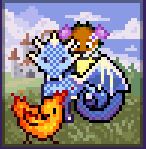
As I mentioned in my initial post, I planned to use this Write-A-Thon to assess and evaluate what’s working for me and what isn’t. Part of that evaluation is to assess my productivity tools. I was thinking about writing sprints, for example, and how they affect my word count goals.
To that end, I’ve realized that a lot of the times notebooks and planners don’t work for me. I’d love to say: “Yes! Putting pen to paper is the best idea ever!” Except, I have a thousand notebooks, post-its, etc. filled with all kinds of lists. Unless it’s a to-do list, it just doesn’t work for me.
Focusing on that part of my productivity, I circled back to Habitica and am now using it more regularly. (I am @booksofm) on that platform if you want to quest with me.) One tiny aspect of Habitica I hadn’t leveraged in the past is the negative points value, or the damage taken from Habits and Dailies. When I started using that, I got more out of it because it wasn’t just about getting things done. It was also about not doing specific things.
For clarification, Habitica has four categories: Habits, Dailies, To-Dos, and Rewards. Habits are a plus or minus feature that has built-in streaks. Dailies are routine-oriented tasks. The way I use Dailies is to plug in things like my newsletter or something that has more gravitas, like exercise, because those are more concerted efforts than taking my vitamins or doing the dishes. The To-Dos section I use to plug in projects that have deadlines or items on my To-Do list. These are things that often take considerable effort and have multiple steps. Finally, Rewards is your in-game loot, which you get for completing items. You can also create custom Rewards as well.
To gamify Habitica further, there are four things I would love to see. I will probably suggest these at some point; I’m not really active in that community and don’t have the programming skills to help. Right now, this is just me “musing” out loud.
- Assign Damage to Missed Deadlines on To-Dos: One of the nice features about To-Dos is that you can assign a Deadline. I really like the “Scheduled” view for To-Dos
which re-orders the items based on due date. I’d love to take that a step further, and have damage taken for a missed deadline. (Even something small like a quarter point per day would be valuable.) - Optional: Assign Rewards to To-Dos: Sometimes, there’s To-Dos I have to complete that I really don’t want to. By assigning a Reward to a To-Dos, it’d be a specific reminder that action has consequences.
- Optional: Add a Projects Category: For me, To-Dos is a combination one-off projects and multi-tiered assignments, so being able to use the existing functionality as another category would help me separate the one-off To-Dos from the larger projects. This functionality already exists within the To-Dos category; you can add multiple steps to a To-Dos that you’d need to check off. Basically, I just want the bigger ones broken out from the one-offs visually, and I’d sacrifice Habits to do that. But, I can see how some people need Habits, which is why I’m suggesting that be optional.
- Optional: Calendar Integration: I would love to have the ability to integrate my digital calendar with the deadline functionality, but as an option. Again, I’m looking at those longer-term projects I’m already plugging in to get reminders on. If there isn’t a way to do that, I’d take alerts or reminders instead.
Habitica’s strength is that it does gamify your to-do list and it is fun. I love the 8-bit look and feel to Habitica; it’s very old school. If interested, check out Habitica.com.
Other Clarion Write-A-Thon Posts
- Week Zero: Outlining the Project
- Week One: Brainstorming and Selection
- Week One: More on Catarina the Wise
About this Post: In exchange for sponsor support, I promised to highlight how I’m processing my identity as an Italian-American and daughter of an immigrant through brainstorming, story selection, and first drafts. If you’re keen on following my progress, warts and all, I encourage you to become my sponsor and sign up for my newsletter.
